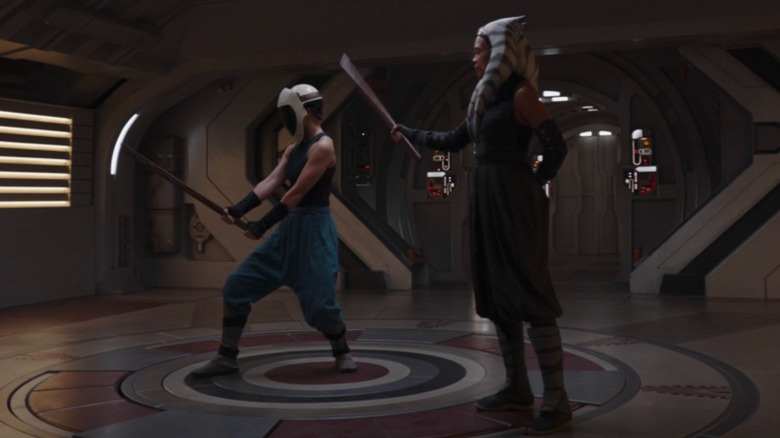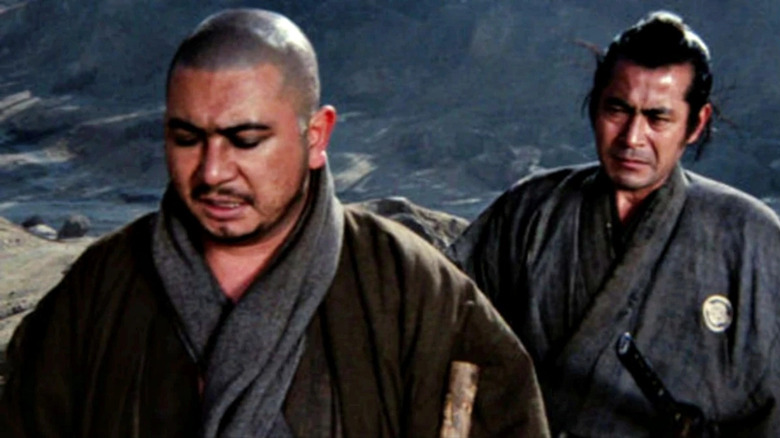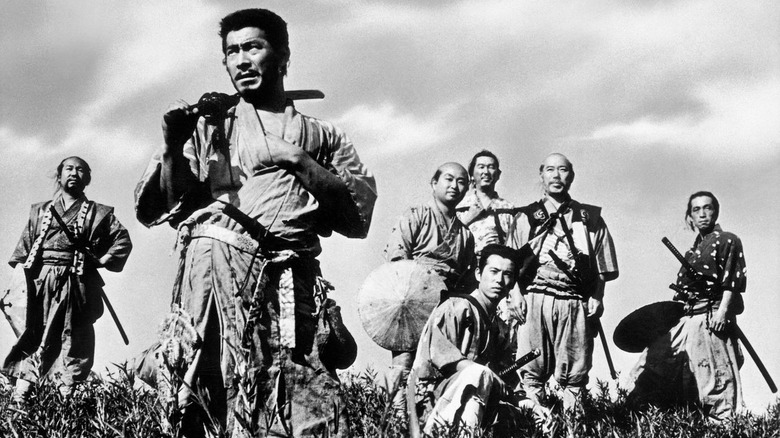Ahsoka's Jedi Training Technique Is A Reference To Classic Japanese Cinema
There will be spoilers for "Star Wars: Ahsoka" Chapter 3 – Time to Fly
The third episode of "Ahsoka," titled "Time to Fly," begins for Sabine Wren (Natasha Liu Bordizzo) with an extended training sequence. At first, she's drilling with the Jedi droid Huyang (David Tennant), but then Ahsoka (Rosario Dawson) arrives and believes she needs something a little more difficult. That's when Ahsoka suggests a training regimen called "Zatochi."
Huyang is convinced that Sabine is clearly not ready for such an exercise, but Ahsoka is adamant. Ahsoka then puts a blast helmet on Sabine, much like Obi-Wan Kenobi does to Luke Skywalker in "A New Hope," and tells her to stretch out with her feelings and block her blows without being able to see. Just like Huyang thought, Sabine is not very good at this, but she gives it the best she has. But there's more than a "Star Wars" reference here in this training exercise. The name of this technique actually calls back to a classic Japanese film.
Classic cinema!
For those who are familiar with it, the word "Zatochi" sounds an awful lot like "Zatoichi." For fans of Japanese cinema, they would have instantly recognized the reference. "Zatoichi" is Japan's longest running film series. It tells the story of a blind man named Zatoichi, who poses as an itinerant gambler and masseur but is secretly an incredibly skilled swordsman.
Almost 30 movies and more than 100 episodes of television have been produced starring the character, and it has been a mainstay in Japanese cinema since 1962. Toho released the latest installment in the saga of Zatoichi in 2010, with a film called "Zatoichi: The Last".
The first 25 films in the series have been released by the Criterion Collection in a deluxe boxset, a must-have for any fans of Samurai cinema. The 20th film in the saga of Zatoichi is actually called "Zatoichi Meets Yojimbo" and stars Toshiro Mifune as Yojimbo, making it a sort-of-sequel to the Akira Kurosawa masterpiece "Yojimbo," which was highly influential on George Lucas and many other filmmakers working on "Star Wars."
The 2004 release, "The Blind Swordsman: Zatoichi" was praised by Roger Ebert before his passing as the sort of film he seeks out. "[It is] not a continuation of the series, but a transformation," he once wrote, showing a vitality to the series even after 50 years.
When you add up the evidence, tying the sightless Jedi exercise to a name like Zatochi can't possibly be a coincidence.
Jedi and jidaigeki
This isn't the first time concepts, terms, and flourishes from Japanese Cinema has found its way into "Star Wars". Even the word Jedi itself comes from the long history of Japanese genre pictures. The word jidaigeki literally means "period dramas," and they are typically set during the Edo period of Japan, though some happen earlier and others later. This was the milieu in which much of Akira Kurosawa's happened in. Kurosawa is a longstanding influence on "Star Wars", with "The Hidden Fortress", "Yojimbo", and "Seven Samurai" playing a huge part of the formation of the things that make the Skywalker saga "Star Wars." But the word itself, jidaigeki, is likely where the word Jedi itself was derived.
So, the Jedi, named for the style of film most typified by the use of Samurai, naming a style of exercise after one of the most beloved examples of that genre of film, "Zatoichi", feels rather appropriate.
New episodes of "Ahsoka" premiere on Tuesday nights on Disney+ at 9:00 PM EST.


